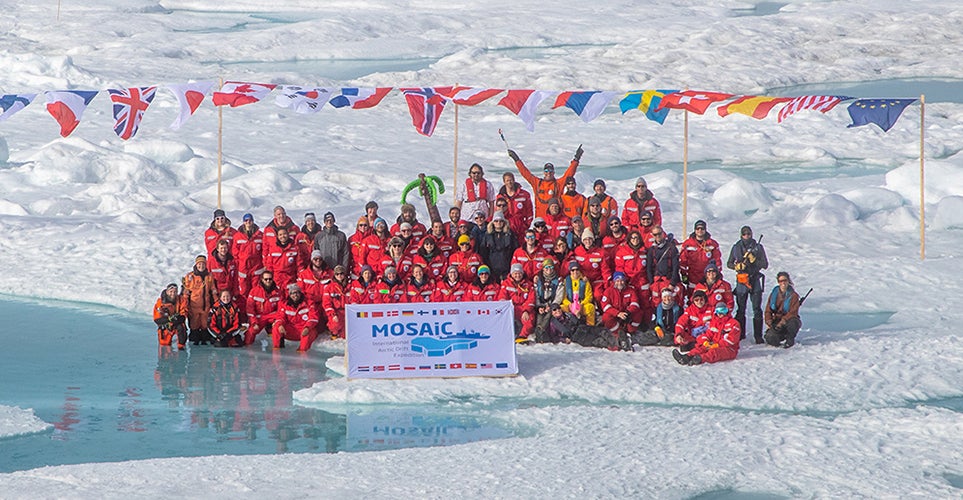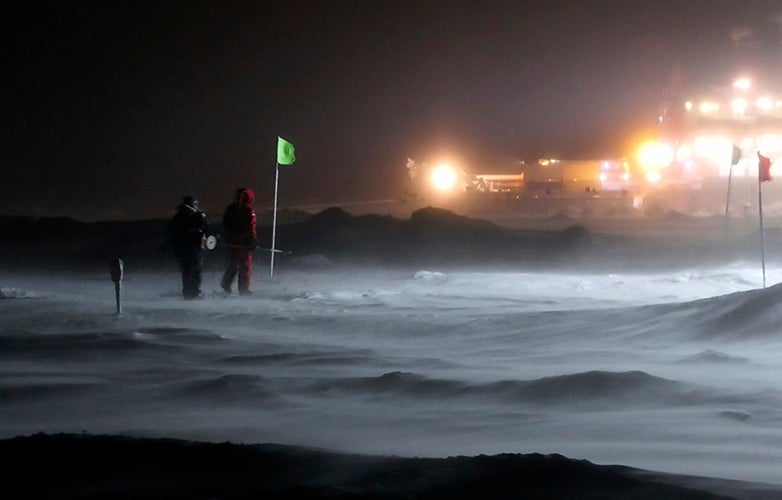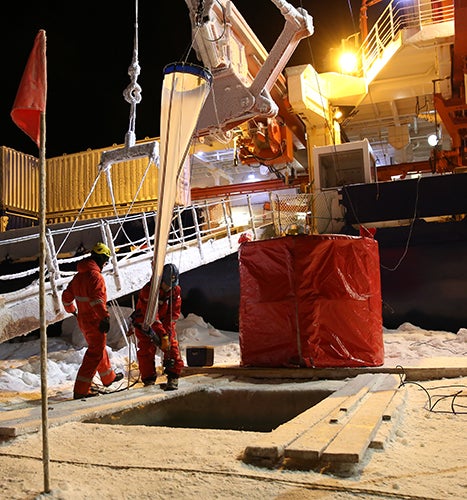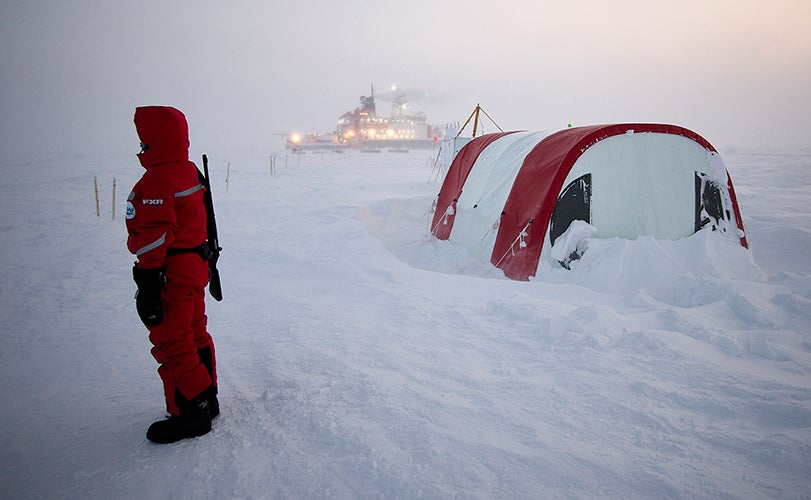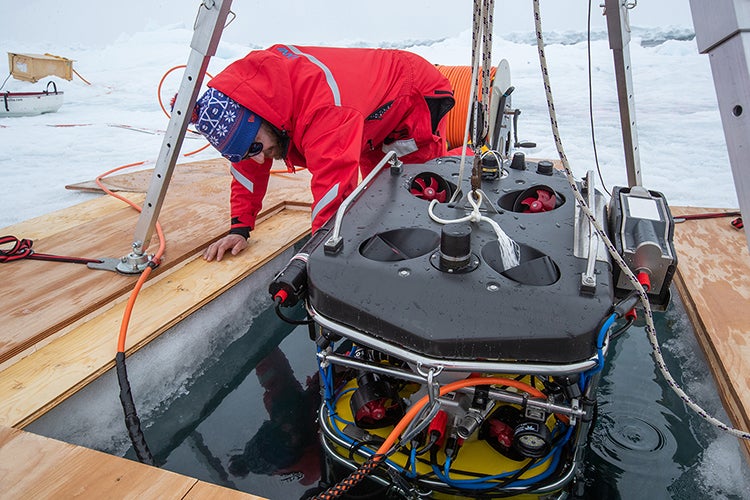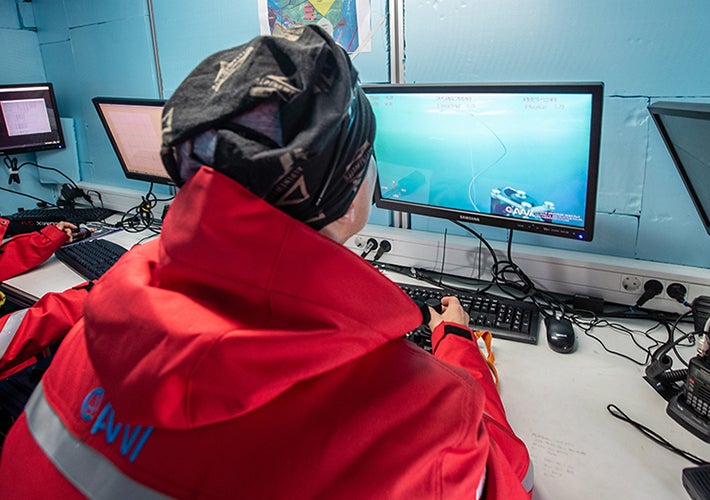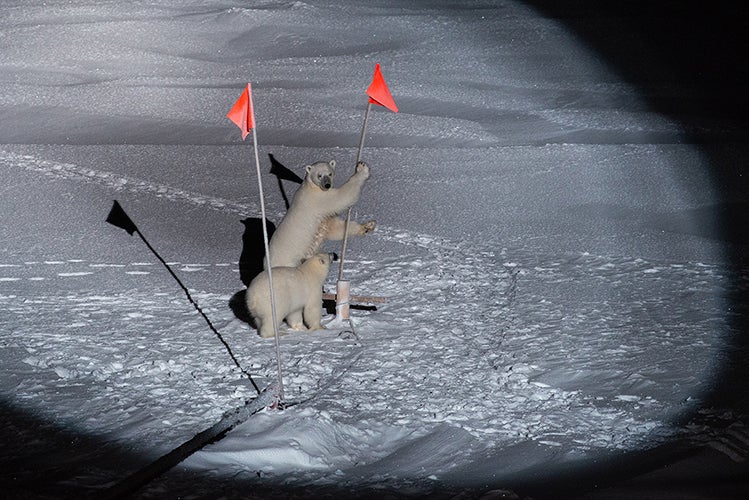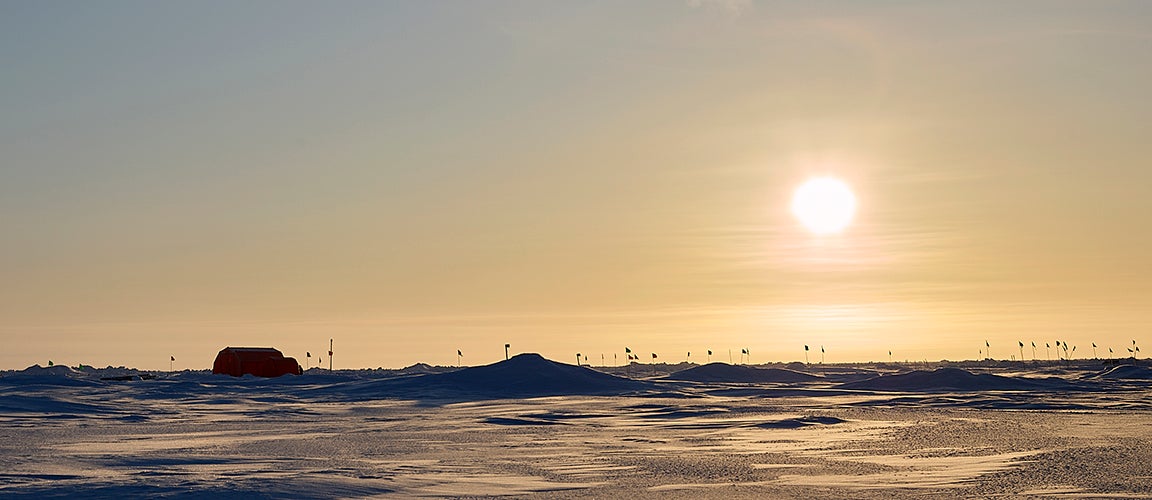By Todd McLeish
Adrift on the Arctic ice, five GSO researchers joined with 600 other scientists from 19 nations to collect data during the year-long MOSAiC Expedition.
It was planned as the largest Arctic science expedition in history:
Trapping the German icebreaker Polarstern in the ice near the North Pole for 13 months as scientists collected urgently-needed data on the Arctic ecosystem and the interactions between the atmosphere, ocean and sea ice. But when the COVID-19 pandemic struck a few months after the project started, it led to innumerable challenges that disrupted the work, delayed the transfer of personnel, and required the establishment of new protocols.
Yet through it all, the research team—including five scientists from the Graduate School of Oceanography—persevered and completed most of what they set out to accomplish.
“This project was 10 years in the making,” said Brice Loose, GSO associate professor and one of the organizers of the expedition. “There was a recognition among many disciplines within the Arctic sciences that there had been an extreme regime shift in the way the ocean and atmosphere were working. What we thought we knew about the Arctic didn’t necessarily apply anymore.”
The $150 million MOSAiC expedition (Multidisciplinary Drifting Observatory for the Study of Arctic Climate) sought new insights from the epicenter of the changing climate as well as some of the first oceanographic data gathered from the region during winter. To collect a baseline understanding of what some are calling the New Arctic required an interdisciplinary approach and a year of continuous data collection to enable scientists to observe the life cycle of plankton and the physical processes taking place from month to month and season to season.
The atmosphere is moving at one speed and direction, the ice is moving at a different speed and direction, and the ocean is moving at a third speed and direction.Professor Brice Loose
But why get trapped in the ice? In part, it was the most practical solution, Loose said. It’s not feasible to navigate the ice floes throughout the winter, and it allowed scientists to use the ice as a platform for conducting their studies.
“The atmosphere is moving at one speed and direction, the ice is moving at a different speed and direction, and the ocean is moving at a third speed and direction,” he said. “We just had to pick a frame of reference and stick with it.”
Aboard ship at various times during the year, Marine Research Scientist Robert Campbell, Marine Research Specialist Celia Gelfman and Postdoctoral Fellow Katy Shoemaker studied the feeding, growth, reproduction and respiration of the Arctic zooplankton community.
“We focused on a few key species throughout the drift and tried to get a better understanding of their complete life cycles,” said Campbell, who spent several months on the ship last winter and again this fall. “We’re using the measurements we made to better understand the Arctic planktonic food web and to quantify energy flow and nitrogen and carbon transformation processes throughout the planktonic ecosystem.”
A typical day for Campbell started with experimental readings before breakfast and often didn’t conclude until well after midnight. He worked from the ship three or four days each week deploying CTDs to collect water samples as deep as 4,000 meters and to measure salinity, pressure, depth and other variables. They also deployed net systems, cameras and particle counters to collect and count plankton from different depths. During other days he worked from the ice, drilling and collecting ice cores for other studies or sampling plankton with small nets from a hole in the ice.
“On Saturdays we got to use the ‘Beast’, an ROV that has its own container on the ice away from the ship and is equipped with plankton nets,” he said. “We used it to collect plankton samples directly under the ice.”
For Gelfman, the hardest part of the expedition was just getting to the ship. By the time her leg of the expedition was approaching, the pandemic was in full swing. After more than a month of delay, she, Shoemaker and Postdoctoral Fellow Alessandra D’Angelo flew to a hotel in Germany for two weeks of isolation, then boarded a ship to Svalbard where the Polarstern exchanged personnel after leaving the icepack. The entire process took more than a month.
Once the ship was back in the ice, Gelfman fell into a similar routine as Campbell had before her. But rather than extreme cold and near total darkness all day long, she enjoyed round-the-clock daylight and temperatures that hovered around freezing.
“For me, what was most interesting to think about was that we were on a boat moving with an ice floe, so every time we put our nets in the water, the ice itself was always the same but the water underneath was always different,” she said. “We were moving through seasonal time, but also through geographic space. As a result, there’s going to be a lot of stuff we’re going to have to correlate in our analysis.
“We also experienced a freshwater lens from the meltwater on the ice,” Gelfman added. “As the ice melted, it made a layer of freshwater on the surface, and it seemed like we had a plankton bloom that was related to that freshwater melt and release of nutrients. We sampled during those conditions, and I’m excited to see the progression of young copepods feeding during that part of the year.”
Loose’s research examined the occurrence of a group of microorganisms that produce or consume methane and their role in mitigating the release of large quantities of methane from the ocean bottom, which is hypothesized will take place as a result of the changing climate.
“A tremendous amount of methane is trapped in the seafloor, more than you’d ever want to have get into the atmosphere,” Loose said “It’s trapped in one kind of ice or another, and that ice is stable at certain temperatures and pressures. But if the temperature or pressure changes, a lot of that methane could be released into the water column. Our question is, will that methane make it to the atmosphere, or will the microbes eat it first?”
Since Loose didn’t spend any time aboard the ship, most of his data collection was left to D’Angelo, the team leader for all of the biogeochemical studies during the expedition. She collected ice core and seawater samples every week to analyze their methane and carbon dioxide concentrations and isotopic ratios.
“We want to know the rate of oxidation or production of methane by the microbes so we can understand how much might be released into the atmosphere,” she said. “The more sea ice there is, the less methane will be exchanged with the atmosphere because the ice blocks the exchange.”
All of the GSO participants in the expedition had joined many previous Arctic research cruises, but the total number of scientists involved in the MOSAIC expedition and the variety of disciplines they represented made this one special.
“I really appreciated the effort everyone put into building new research ideas and new collaborations,” D’Angelo said. “We were very, very busy, so you don’t expect to have extra time to work on other research projects, but we were very willing to do it anyway. We created new research activities in parallel with our work. It was a good way to develop new ideas, new networks, and new collaborations for future proposals.”
One variable in daily activity that was impossible to predict was the presence of polar bears. Gelfman, D’Angelo and Shoemaker saw polar bears nearly every day, and if they approached too closely, research activities on the ice had to be curtailed. “It was nice to see polar bears when we were on the ship,” D’Angelo quipped,
“but not so nice when we were on the ice.”
While pandemic protocols made it difficult for the scientists to get to the ship and back home again—and many scientists never made it to the ship at all due to restrictions in their home countries—the virus wasn’t something they thought much about while at sea. “The coronavirus didn’t touch us on the ship, but now that we’ve come back it seems strange to wear a mask,” said D’Angelo. “Everything is so different and new.”
Although there is still a great deal of data analysis to be done with the samples collected during the expedition, the scientists have already made some interesting observations.
“We found that most animals in winter were found at depth, 500 to 2,000 meters in diapause, and some of these were already producing eggs in December that would float to the surface so that their offspring would be ready to feed on the spring bloom once it started in late spring,” Campbell said. “This is a very important life cycle strategy given the short growing season. We also found that some animals remain active in the surface during the winter. How were they fueling this activity during the polar night when food is so limiting? We hope to find this out from our analysis of the DNA of the prey items in their stomach contents.”
On the last day of her quarantine after returning home from the Arctic, Gelfman said that one thing she most appreciated during the MOSAIC cruise was the opportunity to walk around on the ice on a regular basis.
“It’s a place that not many people get to see, and it’s so diverse and different every week,” she said. “There would be surface melting that would refreeze at night, and the ice crystal formations were always interesting. Like most cruises, it was wonderful to spend every day focused on your work. But this one was special in so many ways—great people, great science, great place.”

